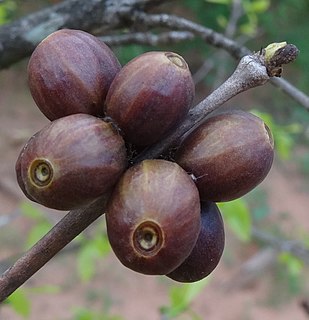
The Rubiaceae are a family of flowering plants, commonly known as the coffee, madder, or bedstraw family. It consists of terrestrial trees, shrubs, lianas, or herbs that are recognizable by simple, opposite leaves with interpetiolar stipules and sympetalous actinomorphic flowers. The family contains about 13,500 species in about 620 genera, which makes it the fourth-largest angiosperm family. Rubiaceae has a cosmopolitan distribution; however, the largest species diversity is concentrated in the tropics and subtropics. Economically important genera include Coffea, the source of coffee, Cinchona, the source of the antimalarial alkaloid quinine, some dye plants, and ornamental cultivars.

Alberta is a monotypic genus of flowering plants in the family Rubiaceae. Most species have been transferred to the genus Razafimandimbisonia, except for the type species Alberta magna. It is native to KwaZulu-Natal, South Africa and is commonly known as Natal flame bush.
Bertiera pauloi is a species of flowering plant in the family Rubiaceae. It is endemic to Tanzania.

Bertiera is a genus of flowering plants in the family Rubiaceae. It comprises 57 species with most known from tropical Africa, five known from various Indian Ocean islands and five found in the tropics of the Americas.
Blepharidium is a monotypic genus of flowering plants in the family Rubiaceae. The genus contains only one species, viz. Blepharidium guatemalense, which is native to Guatemala, Honduras and southern Mexico. Older works might mention two species.
Afrocanthium keniense is a species of flowering plant in the family Rubiaceae. It is endemic to Kenya. It is threatened by habitat loss.
Gardenia storckii, locally known as Mbolovatu or Ndrenga, is a species of flowering plant in the family Rubiaceae. It is the only gardenia occurring abundantly in the forested area of Serua Province in southeastern Viti Levu, to which it's range is confined. It has been noted in dense, dry, or secondary forest as a slender tree 2-15m high and with a trunk to 14cm in diameter. Flowers have been obtained in January through March, and fruits between April and November. It produces an abundance of latex. The resiniferous buds are used for chewing, and an extract of the roots is used medicinally for constipation.
Glionnetia is a monotypic genus of flowering plants in the family Rubiaceae. The genus contains only one species, viz. Glionnetia sericea, which is endemic to Mahé and Silhouette Island in the Seychelles. The species thrives mainly on high ridges in the mountains and it does not seem to grow well at lower altitudes. Glionnetia sericea is a small flower with paniculate terminal inflorescences and it has capsules that are dispersed by wind.

Guettarda is a plant genus in the family Rubiaceae. Most of these plants are known by the common name velvetseed. Estimates of the number of species range from about 50 to 162. Most of the species are neotropical. Twenty are found in New Caledonia and one reaches Australia. A few others are found on islands and in coastal areas of the Indian and Pacific Oceans.

Palicourea is a plant genus in the family Rubiaceae. It contains about 200 species, which range from shrubs to small trees, and is distributed throughout the New World tropics.
Rhipidantha is a genus of plant in the family Rubiaceae. The only species in the genus is Rhipidantha chlorantha which is endemic to Tanzania.
Robynsia is a monotypic genus of flowering plants in the family Rubiaceae. It was described by John Hutchinson and was named after his friend and colleague Walter Robyns. The genus contains only one species, Robynsia glabrata, which is found in Ghana, Ivory Coast and Nigeria. The species is morphologically similar to the genus Cuviera but differs by having long, slender corolla tubes.

Rondeletia is a genus of flowering plants in the family Rubiaceae. It is endemic to the Neotropics. There are around 160 species.

Atractocarpus chartaceus, commonly known as the narrow-leaved gardenia, is a species of evergreen flowering plant in the madder and coffee family Rubiaceae. It is mostly found in subtropical rainforest of eastern Australia, and it is cultivated for its fragrant flowers and colourful fruit.

Naucleeae is a tribe of flowering plants in the family Rubiaceae and contains about 183 species in 24 genera. Species belonging to Naucleeae occur from Australasia, tropical Asia, Madagascar, tropical Africa, and to the Neotropics and North America.
Plocama tinctoria is a species of flowering plant in the family Rubiaceae. It is endemic to northern Somalia and the Socotra archipelago of Yemen. Its natural habitat is subtropical or tropical dry forests. It is listed by the IUCN as a threatened species under the basionym Gaillonia tinctoria.
Chapelieria is a monotypic genus of flowering plants in the family Rubiaceae. The genus contains only one species, viz. Chapelieria madagascariensis, which is endemic to Madagascar.
Pavetta kimberleyana is a species of plant in the family Rubiaceae. It is native to northern Australia where it is largely restricted to the Kimberley region of north-western Western Australia.

Coffea racemosa, also known as racemosa coffee and Inhambane coffee, is a species of flowering plant in the family Rubiaceae. It has naturally low levels of caffeine, less than half of that found in Coffea arabica, and a quarter of that in Robusta coffee. It is endemic to the coastal forest belt between northern KwaZulu-Natal in South Africa and Zimbabwe, found in an area less than 150 km2 (58 sq mi) in size. It was widely cultivated by the Portuguese during the 1960-1970s in Mozambique, currently there are only two plantations at Ibo Island and in Hluhluwe, which remain.

Tarenna sechellensis is a species of plant in the family Rubiaceae. It is known from the Seychelles, Madagascar and Mayotte. The English botanist John Gilbert Baker was the first to formally describe this species in 1877, subsequently V. S. Summerhayes assigned the species to the genus Tarenna.










